weight SAAB 9-3 2002 Owners Manual
[x] Cancel search | Manufacturer: SAAB, Model Year: 2002, Model line: 9-3, Model: SAAB 9-3 2002Pages: 256, PDF Size: 11.55 MB
Page 18 of 256
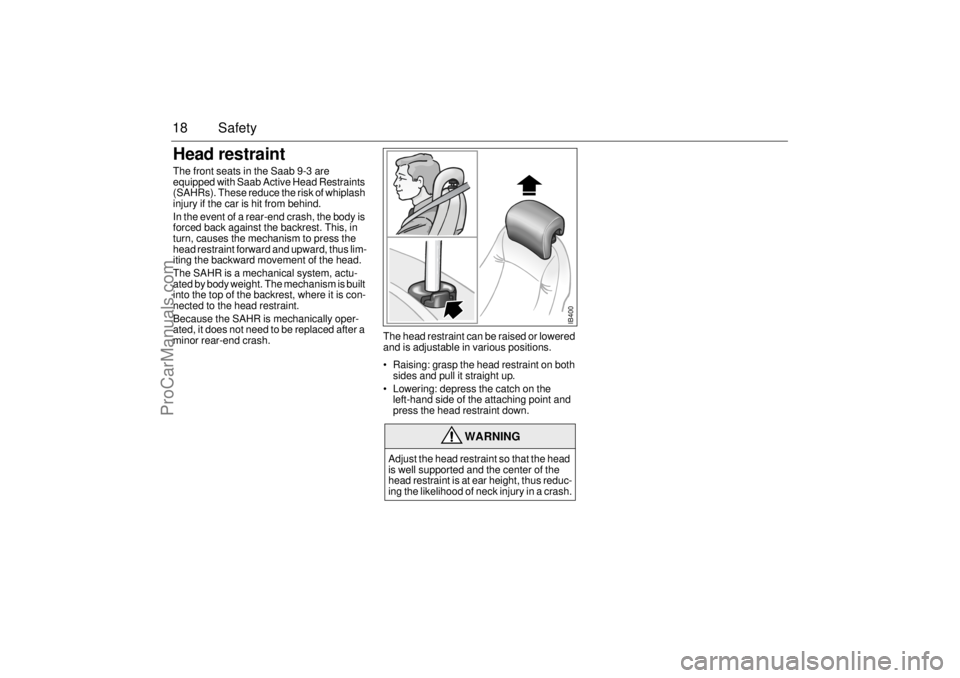
18 SafetyHead restraintThe front seats in the Saab 9-3 are
equipped with Saab Active Head Restraints
(SAHRs). These reduce the risk of whiplash
injury if the car is hit from behind.
In the event of a rear-end crash, the body is
forced back against the backrest. This, in
turn, causes the mechanism to press the
head restraint forward and upward, thus lim-
iting the backward movement of the head.
The SAHR is a mechanical system, actu-
ated by body weight. The mechanism is built
into the top of the backrest, where it is con-
nected to the head restraint.
Because the SAHR is mechanically oper-
ated, it does not need to be replaced after a
minor rear-end crash.The head restraint can be raised or lowered
and is adjustable in various positions.
Raising: grasp the head restraint on both
sides and pull it straight up.
Lowering: depress the catch on the
left-hand side of the attaching point and
press the head restraint down.
WARNING
Adjust the head restraint so that the head
is well supported and the center of the
head restraint is at ear height, thus reduc-
ing the likelihood of neck injury in a crash.
IB400
ProCarManuals.com
Page 26 of 256
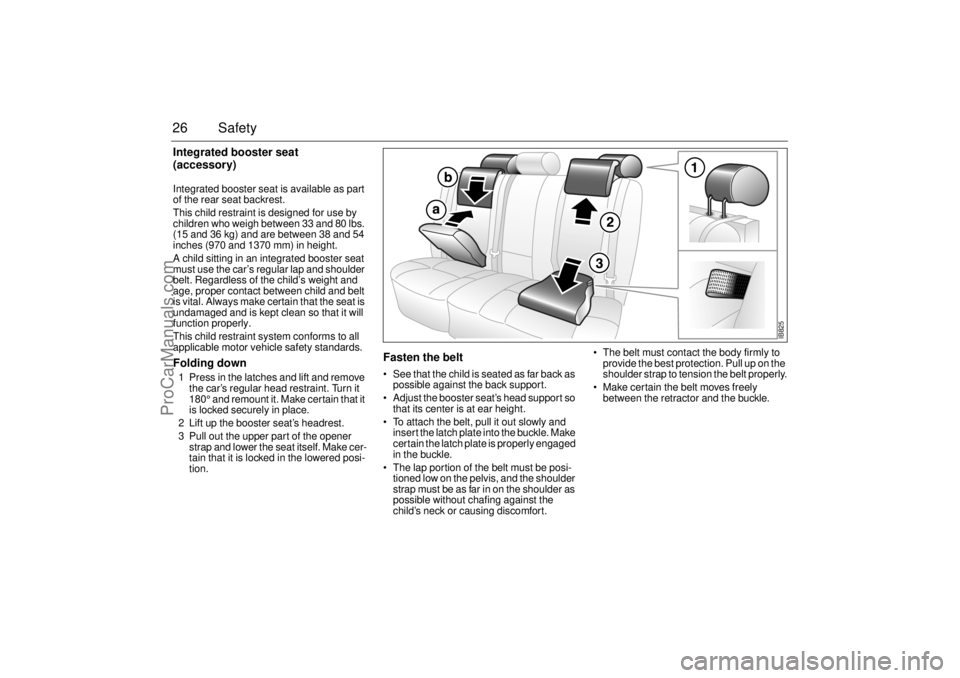
26 SafetyIntegrated booster seat
(accessory)Integrated booster seat is available as part
of the rear seat backrest.
This child restraint is designed for use by
children who weigh between 33 and 80 lbs.
(15 and 36 kg) and are between 38 and 54
inches (970 and 1370 mm) in height.
A child sitting in an integrated booster seat
must use the car’s regular lap and shoulder
belt. Regardless of the child’s weight and
age, proper contact between child and belt
is vital. Always make certain that the seat is
undamaged and is kept clean so that it will
function properly.
This child restraint system conforms to all
applicable motor vehicle safety standards. Folding down1 Press in the latches and lift and remove
the car’s regular head restraint. Turn it
180° and remount it. Make certain that it
is locked securely in place.
2 Lift up the booster seat’s headrest.
3 Pull out the upper part of the opener
strap and lower the seat itself. Make cer-
tain that it is locked in the lowered posi-
tion.
Fasten the belt See that the child is seated as far back as
possible against the back support.
Adjust the booster seat’s head support so
that its center is at ear height.
To attach the belt, pull it out slowly and
insert the latch plate into the buckle. Make
certain the latch plate is properly engaged
in the buckle.
The lap portion of the belt must be posi-
tioned low on the pelvis, and the shoulder
strap must be as far in on the shoulder as
possible without chafing against the
child’s neck or causing discomfort. The belt must contact the body firmly to
provide the best protection. Pull up on the
shoulder strap to tension the belt properly.
Make certain the belt moves freely
between the retractor and the buckle.
IB825
ProCarManuals.com
Page 142 of 256
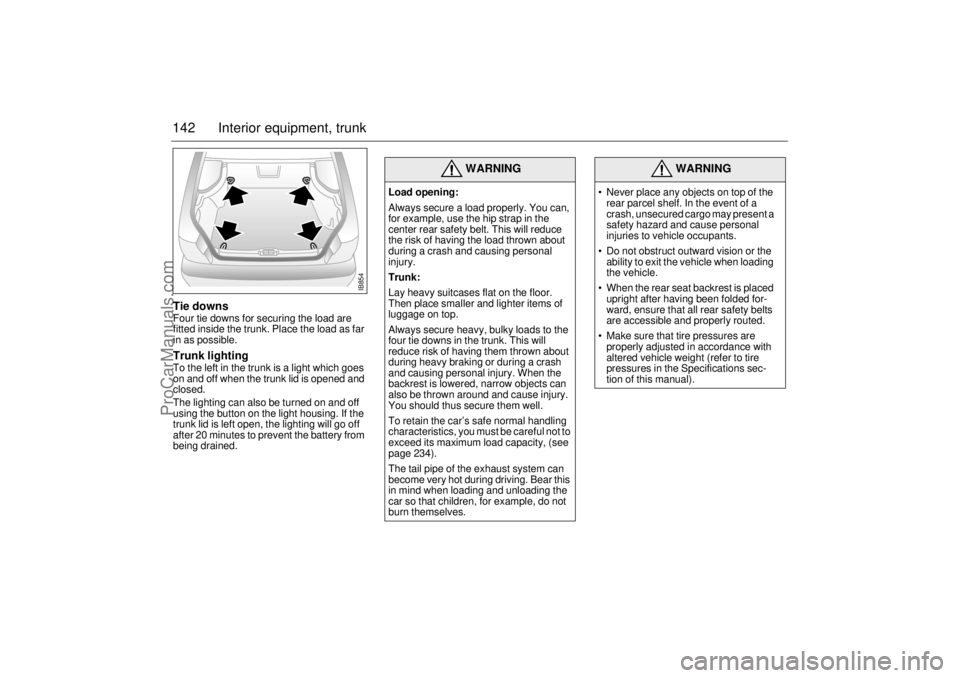
142 Interior equipment, trunkTie downsFour tie downs for securing the load are
fitted inside the trunk. Place the load as far
in as possible.Trunk lightingTo the left in the trunk is a light which goes
on and off when the trunk lid is opened and
closed.
The lighting can also be turned on and off
using the button on the light housing. If the
trunk lid is left open, the lighting will go off
after 20 minutes to prevent the battery from
being drained.
WARNING
Load opening:
Always secure a load properly. You can,
for example, use the hip strap in the
center rear safety belt. This will reduce
the risk of having the load thrown about
during a crash and causing personal
injury.
Trunk:
Lay heavy suitcases flat on the floor.
Then place smaller and lighter items of
luggage on top.
Always secure heavy, bulky loads to the
four tie downs in the trunk. This will
reduce risk of having them thrown about
during heavy braking or during a crash
and causing personal injury. When the
backrest is lowered, narrow objects can
also be thrown around and cause injury.
You should thus secure them well.
To retain the car’s safe normal handling
characteristics, you must be careful not to
exceed its maximum load capacity, (see
page 234).
The tail pipe of the exhaust system can
become very hot during driving. Bear this
in mind when loading and unloading the
car so that children, for example, do not
burn themselves.
WARNING
Never place any objects on top of the
rear parcel shelf. In the event of a
crash, unsecured cargo may present a
safety hazard and cause personal
injuries to vehicle occupants.
Do not obstruct outward vision or the
ability to exit the vehicle when loading
the vehicle.
When the rear seat backrest is placed
upright after having been folded for-
ward, ensure that all rear safety belts
are accessible and properly routed.
Make sure that tire pressures are
properly adjusted in accordance with
altered vehicle weight (refer to tire
pressures in the Specifications sec-
tion of this manual).
IB854
ProCarManuals.com
Page 153 of 256

153 Starting and driving
Other, less common, fuel additives used by
some gasoline dealers are also acceptable,
provided that the resultant gasoline is not
more than 2.7% oxygen by weight. In many
cases, you may not be able to determine the
exact type or percentage by volume of fuel
additive in the gasoline you purchase for
your car.
Some Canadian and U.S. gasolines contain
an octane enhancing additive called meth-
lycyclopentadienyl manganese tricarbonyl
(MMT). If such fuel is used, your emission
control system performance may deterio-
rate and the malfunction indicator lamp on
your instrument panel may turn on. If this
occurs, return to your authorized Saab
dealer for service.
However, these blended gasolines are reg-
ulated and should never exceed these rec-
ommended blend percentages and service
station operators should know if their gaso-
lines contain detergents and oxygenates,
and have been reformulated to reduce vehi-
cle emissions. Nevertheless, if you begin to
notice a problem with the way your car starts
or runs shortly after it has been refueled, try
a different brand of gasoline.
NOTEHigher concentrations of methanol than
listed above, or the use of methanol-
blended gasoline without suitable
co-solvents and corrosion inhibitors,
can damage your car’s fuel system,
leading to the need for repairs which are
not covered by Saab’s product warranty.
NOTEThe engine control module (ECM) mon-
itoring the engine parameters also
stores fault codes.
Under certain circumstances, this may
cause constant illumination of the
Engine malfunction (CHECK ENGINE)
lamp , thus indicating a fault that
must be checked by your Saab dealer,
see page 63.
NOTE: always observe the following two
measures:
Make sure that the fuel filler cap is
screwed on correctly before the
engine is started. Screw on the fuel
filler cap until you hear three distinct
clicks.
Avoid driving with the fuel low level
indicator illuminated. The symbol
illuminates when less than approxi-
mately 2.5 gallons (10 litres) of fuel
remains in the tank.
ProCarManuals.com
Page 173 of 256
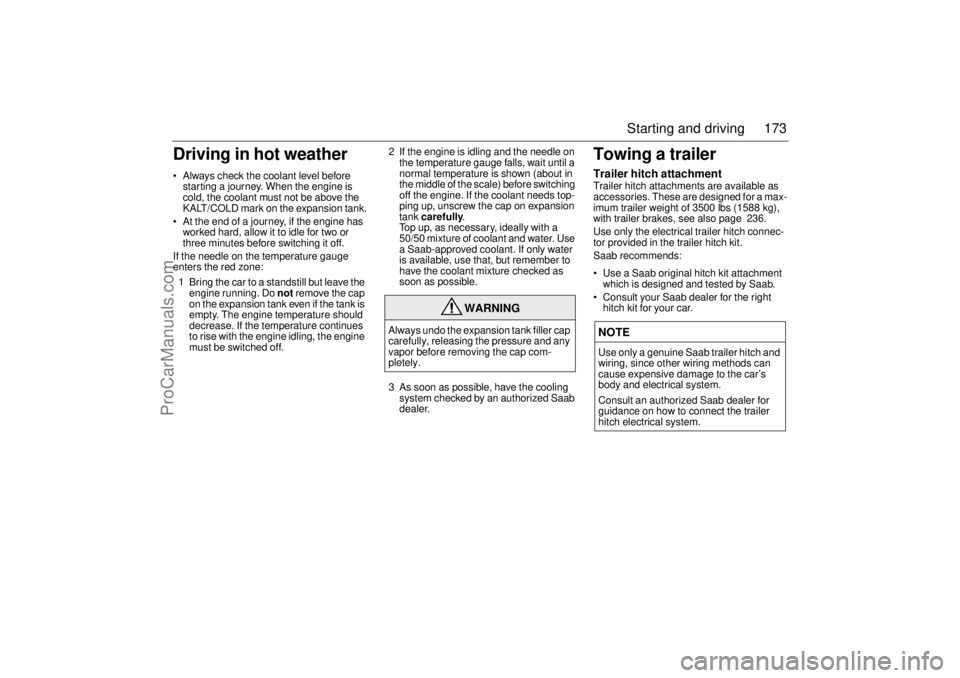
173 Starting and driving
Driving in hot weather Always check the coolant level before
starting a journey. When the engine is
cold, the coolant must not be above the
KALT/COLD mark on the expansion tank.
At the end of a journey, if the engine has
worked hard, allow it to idle for two or
three minutes before switching it off.
If the needle on the temperature gauge
enters the red zone:
1 Bring the car to a standstill but leave the
engine running. Do not remove the cap
on the expansion tank even if the tank is
empty. The engine temperature should
decrease. If the temperature continues
to rise with the engine idling, the engine
must be switched off. 2 If the engine is idling and the needle on
the temperature gauge falls, wait until a
normal temperature is shown (about in
the middle of the scale) before switching
off the engine. If the coolant needs top-
ping up, unscrew the cap on expansion
tank carefully.
Top up, as necessary, ideally with a
50/50 mixture of coolant and water. Use
a Saab-approved coolant. If only water
is available, use that, but remember to
have the coolant mixture checked as
soon as possible.
3 As soon as possible, have the cooling
system checked by an authorized Saab
dealer.
Towing a trailerTrailer hitch attachment Trailer hitch attachments are available as
accessories. These are designed for a max-
imum trailer weight of 3500 lbs (1588 kg),
with trailer brakes, see also page 236.
Use only the electrical trailer hitch connec-
tor provided in the trailer hitch kit.
Saab recommends:
Use a Saab original hitch kit attachment
which is designed and tested by Saab.
Consult your Saab dealer for the right
hitch kit for your car.
WARNING
Always undo the expansion tank filler cap
carefully, releasing the pressure and any
vapor before removing the cap com-
pletely.
NOTEUse only a genuine Saab trailer hitch and
wiring, since other wiring methods can
cause expensive damage to the car’s
body and electrical system.
Consult an authorized Saab dealer for
guidance on how to connect the trailer
hitch electrical system.
ProCarManuals.com
Page 174 of 256
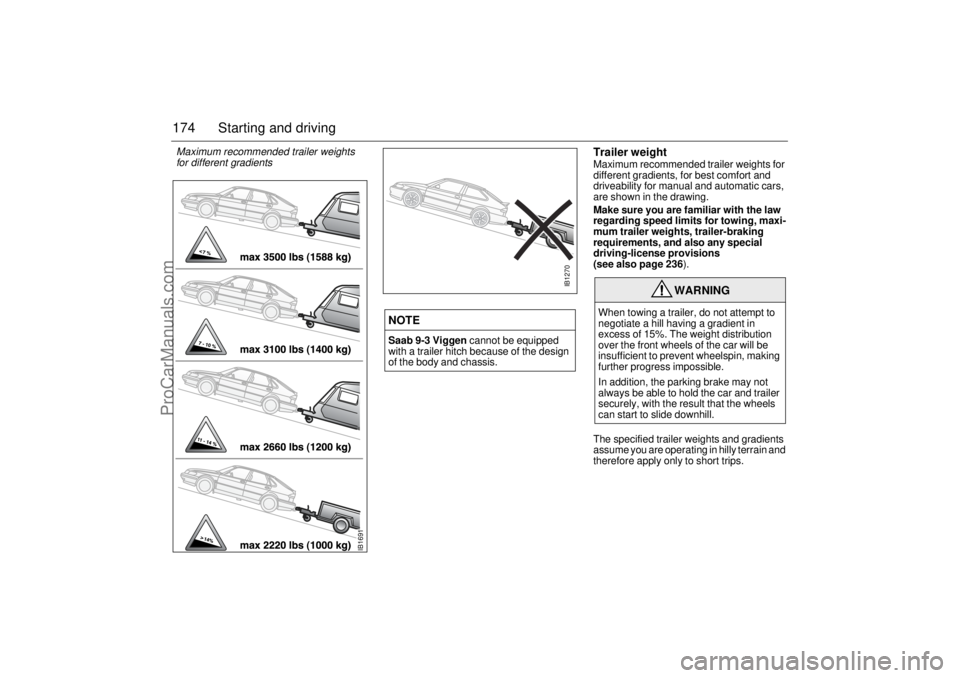
174 Starting and driving
Trailer weightMaximum recommended trailer weights for
different gradients, for best comfort and
driveability for manual and automatic cars,
are shown in the drawing.
Make sure you are familiar with the law
regarding speed limits for towing, maxi-
mum trailer weights, trailer-braking
requirements, and also any special
driving-license provisions
(see also page 236).
The specified trailer weights and gradients
assume you are operating in hilly terrain and
therefore apply only to short trips.
NOTESaab 9-3 Viggen cannot be equipped
with a trailer hitch because of the design
of the body and chassis.
WARNING
When towing a trailer, do not attempt to
negotiate a hill having a gradient in
excess of 15%. The weight distribution
over the front wheels of the car will be
insufficient to prevent wheelspin, making
further progress impossible.
In addition, the parking brake may not
always be able to hold the car and trailer
securely, with the result that the wheels
can start to slide downhill.
IB1691
Maximum recommended trailer weights
for different gradients
IB1270
ProCarManuals.com
Page 175 of 256
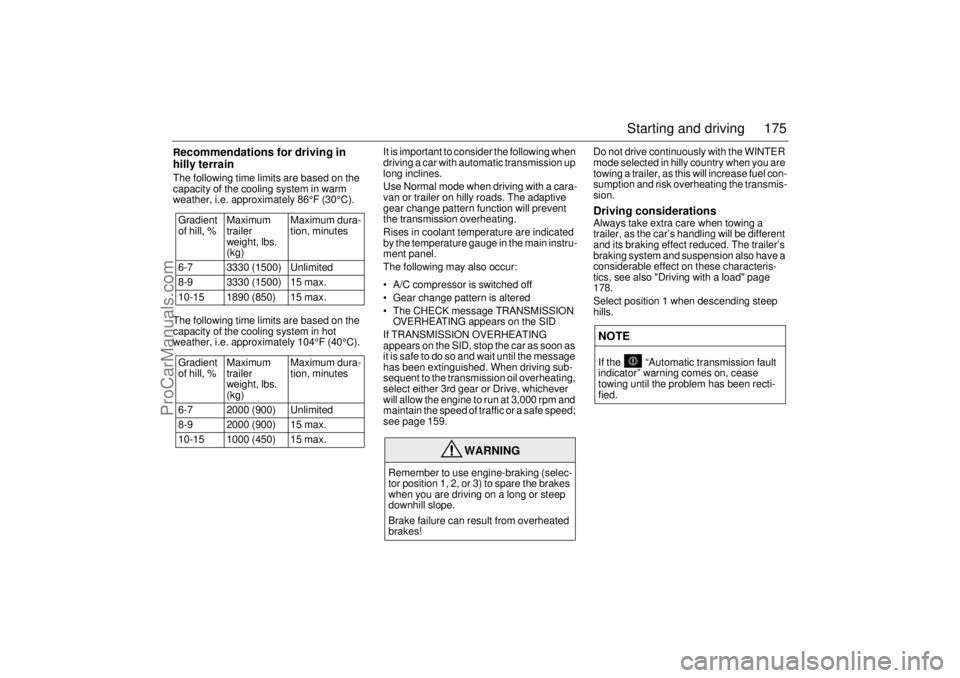
175 Starting and driving
Recommendations for driving in
hilly terrainThe following time limits are based on the
capacity of the cooling system in warm
weather, i.e. approximately 86°F (30°C).
The following time limits are based on the
capacity of the cooling system in hot
weather, i.e. approximately 104°F (40°C).It is important to consider the following when
driving a car with automatic transmission up
long inclines.
Use Normal mode when driving with a cara-
van or trailer on hilly roads. The adaptive
gear change pattern function will prevent
the transmission overheating.
Rises in coolant temperature are indicated
by the temperature gauge in the main instru-
ment panel.
The following may also occur:
A/C compressor is switched off
Gear change pattern is altered
The CHECK message TRANSMISSION
OVERHEATING appears on the SID
If TRANSMISSION OVERHEATING
appears on the SID, stop the car as soon as
it is safe to do so and wait until the message
has been extinguished. When driving sub-
sequent to the transmission oil overheating,
select either 3rd gear or Drive, whichever
will allow the engine to run at 3,000 rpm and
maintain the speed of traffic or a safe speed;
see page 159.Do not drive continuously with the WINTER
mode selected in hilly country when you are
towing a trailer, as this will increase fuel con-
sumption and risk overheating the transmis-
sion.
Driving considerationsAlways take extra care when towing a
trailer, as the car’s handling will be different
and its braking effect reduced. The trailer’s
braking system and suspension also have a
considerable effect on these characteris-
tics, see also "Driving with a load" page
178.
Select position 1 when descending steep
hills. Gradient
of hill, % Maximum
trailer
weight, lbs.
(kg)Maximum dura-
tion, minutes
6-7 3330 (1500) Unlimited
8-9 3330 (1500) 15 max.
10-15 1890 (850) 15 max.
Gradient
of hill, % Maximum
trailer
weight, lbs.
(kg)Maximum dura-
tion, minutes
6-7 2000 (900) Unlimited
8-9 2000 (900) 15 max.
10-15 1000 (450) 15 max.
WARNING
Remember to use engine-braking (selec-
tor position 1, 2, or 3) to spare the brakes
when you are driving on a long or steep
downhill slope.
Brake failure can result from overheated
brakes!
NOTEIf the “Automatic transmission fault
indicator” warning comes on, cease
towing until the problem has been recti-
fied.
ProCarManuals.com
Page 176 of 256
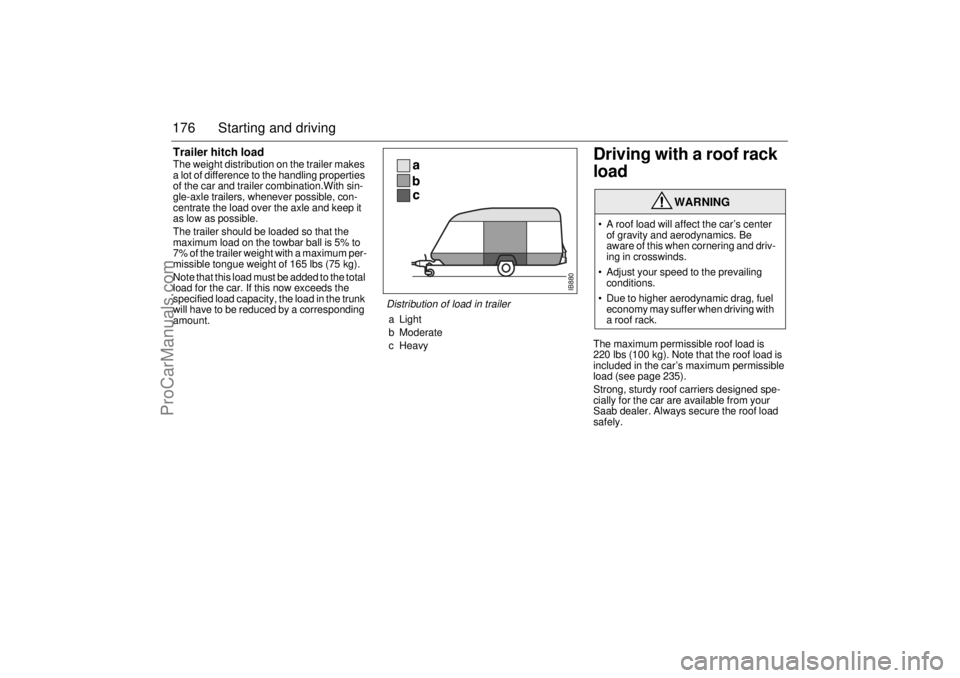
176 Starting and drivingTrailer hitch loadThe weight distribution on the trailer makes
a lot of difference to the handling properties
of the car and trailer combination.With sin-
gle-axle trailers, whenever possible, con-
centrate the load over the axle and keep it
as low as possible.
The trailer should be loaded so that the
maximum load on the towbar ball is 5% to
7% of the trailer weight with a maximum per-
missible tongue weight of 165 lbs (75 kg).
Note that this load must be added to the total
load for the car. If this now exceeds the
specified load capacity, the load in the trunk
will have to be reduced by a corresponding
amount.
Driving with a roof rack
loadThe maximum permissible roof load is
220 lbs (100 kg). Note that the roof load is
included in the car’s maximum permissible
load (see page 235).
Strong, sturdy roof carriers designed spe-
cially for the car are available from your
Saab dealer. Always secure the roof load
safely.
WARNING
A roof load will affect the car’s center
of gravity and aerodynamics. Be
aware of this when cornering and driv-
ing in crosswinds.
Adjust your speed to the prevailing
conditions.
Due to higher aerodynamic drag, fuel
economy may suffer when driving with
a roof rack.
IB880
Distribution of load in trailer aLight
b Moderate
cHeavy
ProCarManuals.com
Page 178 of 256

178 Starting and drivingDriving with a loadThe driving characteristics of the car are
affected by the way it is loaded.
Place heavy loads as far forward and as
low as possible in the trunk.
Secure the load to the tie downs, see
page 142.
The load should be such that the car´s
total weight or axle weight are not
exceeded, see page 235.
Heavy loads mean that the car’s center of
gravity is further back. As a result, the car
will sway more during evasive steering.
Never exceed the permissible load in the
roof box, even if there is room for more.
Ensure that the tire pressure is correct –
slight overinflation is preferable to under-
inflation.
The braking distance of a loaded car is
always greater. Keep your distance from
the vehicle in front.
Tire pressure, see page 211 and back
cover.
TiresThe tire pressure should match the current
load and speed of the car; see the back
cover or the tire pressure label on
page 243.
The tire pressures given apply to cold tires,
that is tires that are the same temperature
as the outside air temperature.
The tire pressure increases as the tires
become warm (e.g. during highway driving)
with approximately 0.3 bar (4 psi). When
the temperature of the tires changes by 50°
(10°C), the tire pressure will change 0.1 bar
(2 psi).Never reduce the pressure of a hot tire. If the
tires are hot when you check them, only
increase the pressure, if necessary.
Underinflated tires wear more quickly than
slightly overinflated tires.
If a valve is leaking, simply unscrew it and fit
a new one.
Important! Remember to adjust the tire
pressures if you change the load in the car
or intend to drive at substantially lower or
higher speeds than normal.NOTECheck the tire pressure at least once a
month. Underinflation is the main cause
of:
Damage to the wheels.
Premature tire wear.
Damage to the sidewalls.
ProCarManuals.com
Page 234 of 256
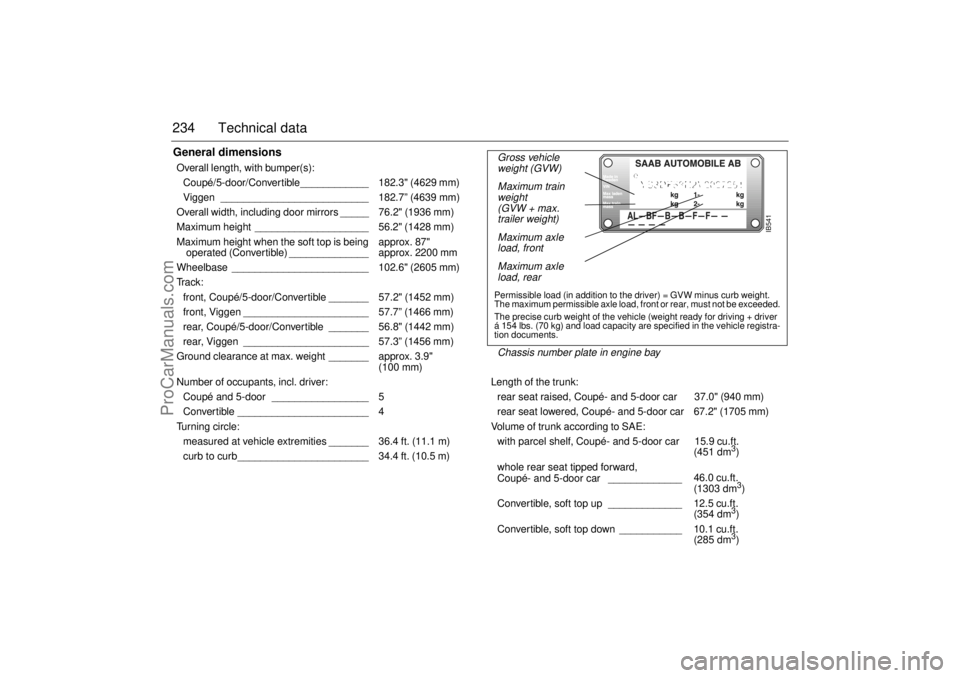
234 Technical dataGeneral dimensionsOverall length, with bumper(s):
Coupé/5-door/Convertible____________ 182.3" (4629 mm)
Viggen __________________________ 182.7” (4639 mm)
Overall width, including door mirrors _____ 76.2" (1936 mm)
Maximum height ____________________ 56.2" (1428 mm)
Maximum height when the soft top is being
operated (Convertible) ______________approx. 87"
approx. 2200 mm
Wheelbase ________________________ 102.6" (2605 mm)
Tr a c k :
front, Coupé/5-door/Convertible _______ 57.2" (1452 mm)
front, Viggen ______________________ 57.7” (1466 mm)
rear, Coupé/5-door/Convertible _______ 56.8" (1442 mm)
rear, Viggen ______________________ 57.3” (1456 mm)
Ground clearance at max. weight _______ approx. 3.9"
(100 mm)
Number of occupants, incl. driver:
Coupé and 5-door _________________ 5
Convertible _______________________ 4
Turning circle:
measured at vehicle extremities _______ 36.4 ft. (11.1 m)
curb to curb_______________________ 34.4 ft. (10.5 m)
Gross vehicle
weight (GVW)
Maximum train
weight
(GVW + max.
trailer weight)
Maximum axle
load, front
Maximum axle
load, rear Permissible load (in addition to the driver) = GVW minus curb weight.
The maximum permissible axle load, front or rear, must not be exceeded.
The precise curb weight of the vehicle (weight ready for driving + driver
á 154 lbs. (70 kg) and load capacity are specified in the vehicle registra-
tion documents.Chassis number plate in engine bay Length of the trunk:
rear seat raised, Coupé- and 5-door car 37.0" (940 mm)
rear seat lowered, Coupé- and 5-door car 67.2" (1705 mm)
Volume of trunk according to SAE:
with parcel shelf, Coupé- and 5-door car 15.9 cu.ft.
(451 dm
3)
whole rear seat tipped forward,
Coupé- and 5-door car _____________ 46.0 cu.ft.
(1303 dm3)
Convertible, soft top up _____________ 12.5 cu.ft.
(354 dm3)
Convertible, soft top down ___________ 10.1 cu.ft.
(285 dm3)
IB541
ProCarManuals.com